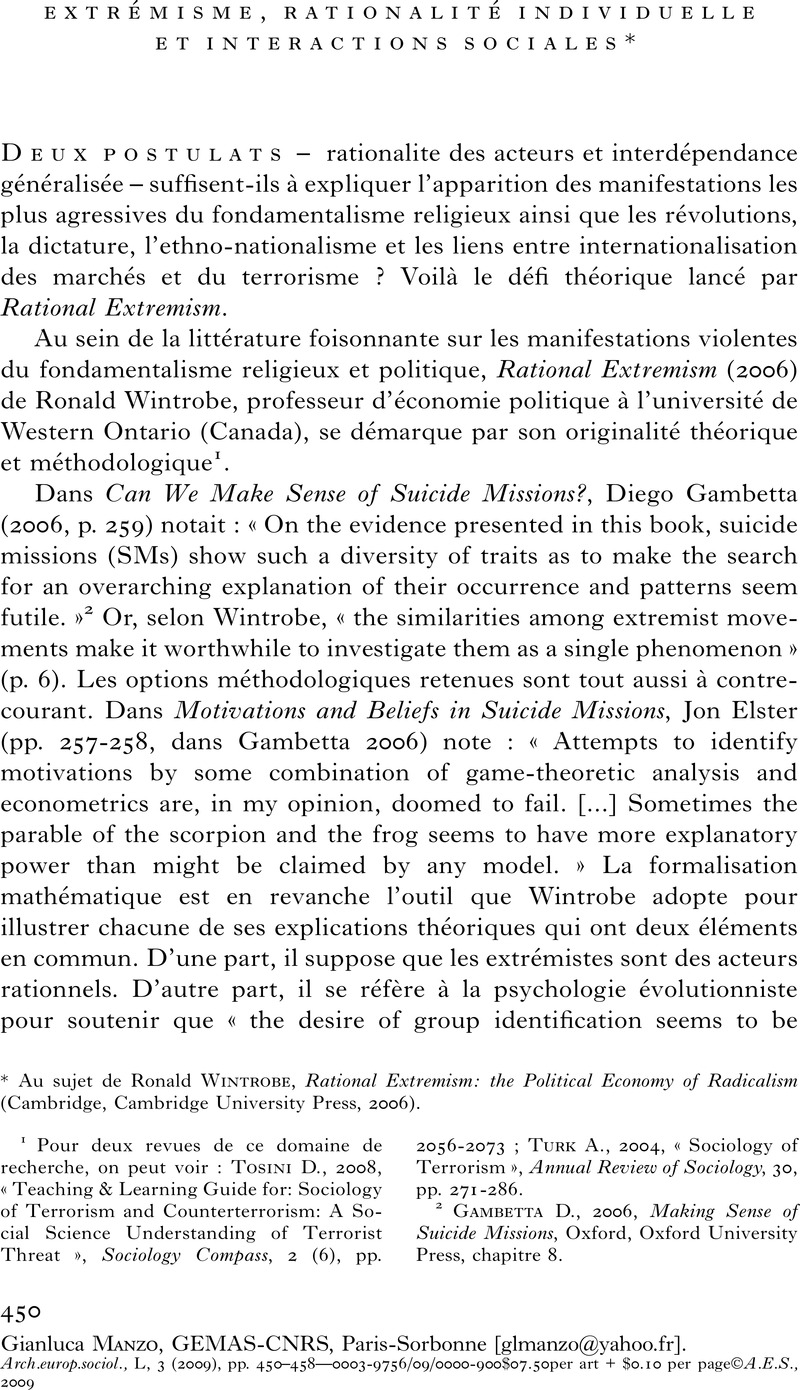No CrossRef data available.
Published online by Cambridge University Press: 04 February 2010

1 Pour deux revues de ce domaine de recherche, on peut voir : Tosini D., 2008, « Teaching & Learning Guide for: Sociology of Terrorism and Counterterrorism: A Social Science Understanding of Terrorist Threat », Sociology Compass, 2 (6), pp. 2056-2073 ; Turk A., 2004, « Sociology of Terrorism », Annual Review of Sociology, 30, pp. 271-286.
2 Gambetta D., 2006, Making Sense of Suicide Missions, Oxford, Oxford University Press, chapitre 8.
3 Voir Schelling Thomas C., 1971, « Dynamic Models of Segregation », Journal of Mathematical Sociology, 1(2), pp. 143-186; Schelling Thomas C., 1973, « Hockey Helmets, Concealed Weapons and Daylight Saving. A Study of Binary Choices with Externalities », Journal of Conflict Resolution, 17(3), pp. 381-428.
4 Voir respectivement, Manski C., 2000, « Economic Analysis of Social Interaction », Journal of Economic Perspectives, 14 (3), pp. 115-136; Durlauf S. N., 2001, « A Framework for the Study of Individual Behaviour and Social Interactions », Sociological Methodology, 31, pp. 47-87.
5 Voir Bacharach M. & Gambetta D., 2001, Trust in Signs, in Karen S. Cook, ed., Trust in Society, NY, Russell Sage Foundation, pp. 148-184.
6 Voir Wikström P.-O., 2006, « Individuals, Settings and Acts of Crime. Situational Mechanisms and the Explanation of Crime », in Per-Olof Wikström & Robert J. Sampson, eds., The Explanation of Crime: Context, Mechanisms and Development, Cambridge, Cambridge University Press.
7 Durlauf S. N., 2006, « Groups, Social Influences, and Inequality: A Memberships Theory Perspective on Poverty Traps », in Samuel Bowles, Steven N. Durlauf and Karla Hoff, eds., Poverty Traps, Princeton, Princeton University Press, pp. 141-175.
8 Voir respectivement Orléan A., 2006, « Mimetic interactions », in Jacques Lesourne, André Orléan and Bernard Walliser, eds., Evolutionary Microeconomics, Berlin-Heidelberg, Springer, pp. 131-172, et Arvid Hoffmann, Wander Jager and Henk Von Eije J. H., 2007, « Social Simulation of Stock Markets: Taking It to the Next Level », Journal of Artificial Societies and Social Simulation, 10, 2, 7.
9 Pour une telle conception de la rationalité, voir Boudon R., 2006, « Are we doomed to see the homo sociologicus as a rational or as an irrational idiot? », in Jon Elster et al., eds., Understanding Choice, Explaining Behaviour, Essays in the Honour of O.-J. Skog, Oslo, Oslo Academic Press, pp. 25-42.
10 Durkheim E., [1897] 2004, Le suicide, Paris, PUF, chapitre IV.
11 Voir par exemple Cherkaoui M., 2006, « Le fondamentalisme islamique. Esquisse d'une interpretation », Commentaire, 114 , pp. 349-361 ; Gambetta D., 2006, « Can We Make Sense of Suicide Missions? », in Diego Gambetta, Making Sense of Suicide Missions, Oxford, Oxford University Press, chapitre 8.
12 Voir Boudon R. 1998, « Limitations of Rational Choice Theory », American Journal of Sociology, 104 (3), pp. 817-828.
13 Voir Boudon R., 1999, « Les Formes élémentaires de la vie religieuse: une théorie toujours vivante », L'Année sociologique, 49 (1), pp. 149-198 ; Boudon R., 2001, « La rationalité du religieux selon Max Weber », L'Année sociologique, 51 (1), pp. 9-50.
14 Voir Granovetter M., 1978, « Threshold Models of Collective Behavior », American Journal of Sociology, 83 (6), pp. 1420-1443 ; Granovetter M., Soong R., 1983, « Threshold Models of Diffusion and Collective Behavior », Journal of Mathematical Sociology, 9, pp. 165-179. Oliver P. and Mardwell G., 2001, « Whatever Happened to Critical Mass Theory? A Retrospective and Assessment », Sociological Theory, 19 (3), pp. 292-311.
15 Sur ce point, voir Kirman, A. P., 1992. « Whom or What Does the Representative Individual Represent? », Journal of Economic Perspectives, 6, pp. 117-136.
16 Voir Epstein J., 2002, « Modeling civil violence: An agent-based computational approach », PNAS, 99 (3), Girardin L., Cederman L.-E., 2007, « A Roadmap to Realistic Computational Models of Civil Wars », in Shingo Takahashi, David Sallach, Juliette Rouchier, eds., Advancing Social Simulation: The First World Congress, Berlin, Springer-Verlag, pp. 59-71; Galam S., 2003, « Global physics: from percolation to terrorism, guerilla warfare and clandestine activities », Physica A, 330, pp. 139-149.
17 Voir, pour une revue, Sobkowicz P., 2009, « Modelling Opinion Formation with Physics Tools: Call for Closer Link with Reality », Journal of Artificial Societies and Social Simulation, 12 (1).